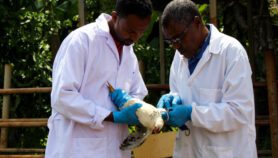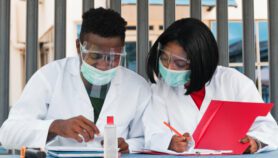Send to a friend
The details you provide on this page will not be used to send unsolicited email, and will not be sold to a 3rd party. See privacy policy.
There have been notable successes in science for development over the past decade but still insufficient follow-through for key commitments.
What progress has science made in the politics of developing countries over the last decade?
Taking stock of its position on socioeconomic agendas reveals a mixed picture. But there is encouraging news about the recognition of the value of science.
First, the main success stories. China, in particular, has successfully met many of the ambitious goals set in the previous decade and has more than doubled its spending on research and development (R&D).
Elsewhere too, growth has been steady. Overall, as figures from the UNESCO Institute for Statistics reveal, the number of researchers in the developing world grew by 50 per cent from 2002–2007, while R&D spending increased three times faster than in the developed world (see Poor countries spending more on science).
Much has therefore been done to reverse the spending trends of the 1980s and 1990s when ‘structural adjustment’ policies came to dominate, followed later by direct spending on poverty alleviation strategies. Too often, science was ignored.
But much more remains to be done in both developed and developing countries.
Some supported science…
Evidence of the positive shift towards science by donors is easy to find. In Europe, for example, countries such as France and Sweden that have long supported science aid, were joined early in the decade by others including the United Kingdom and, more recently, Germany.
The European Union is following suit. Support for joint projects with the developing world has become a significant component of its latest Framework Programme and collaboration with Africa in particular was highlighted in an Africa-EU summit in Lisbon in 2007.
More recently, the arrival of President Barack Obama in the United States has opened the door to similar efforts across the Atlantic. Spurred by the promise of science as a tool for ‘soft diplomacy’, the Obama administration has put scientific cooperation with the developing world — particularly in the Middle East — back on the Washington agenda (even if not in a form explicitly shared in Europe).
Other countries, most notably Australia and Japan, also seem willing to move in the same direction. And this decade, the World Bank — previously a staunch supporter of structural adjustment policies — has reprioritised scientific capacity building in its lending policies.
…but others stopped short
So far, so good. But in the ‘noughties’ we also often saw politicians pay lip service to science for development, rarely following through with financial backing.
Take the annual G8 meetings of leading industrialised nations. During the first half of the decade there was increasing talk of the importance of promoting science for development. At the 2005 Gleneagles summit in Scotland leaders supported a ‘network of centres of excellence’ across Africa and implicitly committed to increase funding significantly.
But towards the end of the decade the meetings lost this momentum as G8 leaders grappled with the financial crisis threatening all development strategies and the challenge of climate change. By the time of this year’s meeting in L’Aquila, Italy, science had disappeared entirely from the G8’s agenda.
In Africa, too, science for development has been a mixed story. The highlight was perhaps the African Union summit meeting in 2007, attended by many heads of state and senior ministers, which aimed to solidify political support for science and included a commitment to increase spending on R&D to one per cent of each country’s gross national product (GNP).
Some countries, ranging from Rwanda and Tanzania in East Africa, to Egypt and Morocco in the North and South Africa in the South, have steadily increased their science spending. But the average R&D spend remains just 0.4 per cent of GNP on the continent.
The African Union continues to debate vigorously how to put commitments into effect but progress remains slow. For example, the Consolidated Plan of Action, adopted with much fanfare in 2005 as the masterplan for Africa’s scientific renaissance, is little more than a wish list (although independent donor funding has allowed some of its components, such as the African Institute of Mathematical Sciences in South Africa, and the Biosciences Eastern and Central Africa facility in Nairobi, to flourish).
And the much heralded African Science and Innovation Fund has yet to see the light of day.
Science proves its worth
So overall the past decade is a mixed picture. But three other positive factors cannot be ignored.
First, despite all the funding ups and downs, science for development has clearly returned to the centre of debate in both the aid policies of developing countries and the national priorities of many developing nations.
Second, it is increasingly accepted that science must earn its place at the table by demonstrating its value, not by assuming it has authority. Science is not now being seen as a magical driver of development policy, but only one component of a complex system of innovation in which other factors (such as technology transfer and intellectual property policies) are equally important.
Third, there is a growing recognition that, for science to improve development, and for development policies to be based on scientific evidence, research results must be communicated accurately to policymakers and the public.
Achievements in each of these areas do not necessarily make headlines. But they remain central to any efforts to put science at the heart of development policy. And of course reporting such efforts will remain central to SciDev.Net’s mission in what promises to be another eventful decade.
David Dickson
Director, SciDev.Net













